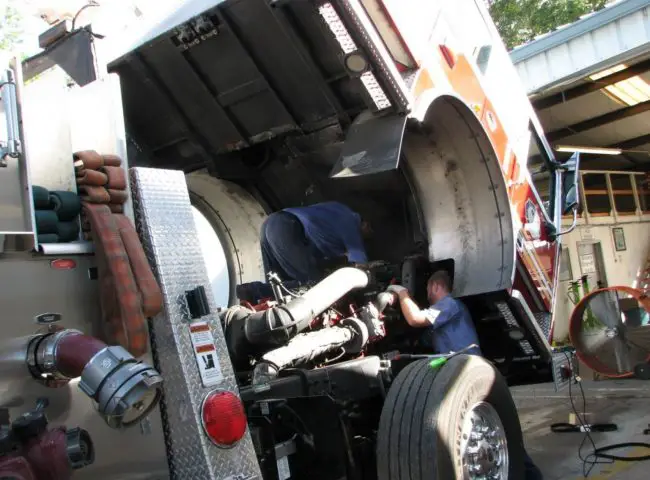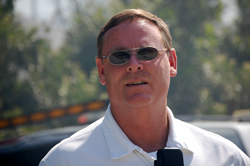
The Palm Coast Fire Department is getting three new fire engines—two of them to be delivered in the next few weeks, and one, all but approved for purchase today, to be delivered next spring. The total cost: $774,034.
The Palm Coast City Council approved two of the three pumper trucks last spring, for $513,356. Palm Coast Fire Chief Mike Beadle was at the manufacturer’s plant in South Dakota earlier this month for a week, inspecting the two new trucks, one of which has already made it to Ocala before it enters service at the main fire station (Station 25) on Belle Terre Parkway near Town Center. The other truck will enter service at the Palm Harbor fire station, and the third will be stationed at Indian Trails (Station 23).
“We’re very happy with the two trucks we just went up and saw,” Beadle said, “We should have them in the station within three to four weeks.”
The council knew last spring that it would be approving the purchase of a third truck about this time. It all but did so at a workshop this morning. It’ll formalize the purchase at a meeting next week.
The price is a bit steeper: $259,678. But it’s well below the cost of custom-made trucks, which would have cost $424,000 to $472,000. The reason for the difference: The commercial trucks don’t last as long as custom-made trucks. But for budgetary reason, they’re what the city could buy and keep its fleet at a full complement of front-line trucks and back-up trucks, without going short on either for a period of years. (Buying used equipment was an option, but the city ruled it out, not wanting to inherit another department’s potential mechanical problems.)

The cost is not expected to be an added burden on the city budget, which for years has included a fire-truck replacement fund that gets an allotted sum of money each year. The city has had such a fund since 2005, Palm Coast Finance Director Chris Quinn said, with $423,803 going into that fund in the coming fiscal year. The annual amount is calibrated to the city’s needs.
“This arrangement allows us to pay cash for vehicles and receive the requisite discounts, not pay interest or lease finance charges, and to earn interest on the fleet replacement funds,” Quinn explained in an email. “This lowers the overall cost to the citizens. The amount currently in the replacement fund, for all vehicles city-wide, is $5.5 million. The anticipated purchases of city-wide replacements, including the new Fire truck for FY17 is $2.3 million. Overall, this funding program has been very successful.”
Beadle is intent on maintaining front-line and back-up engines, or “apparatus,” at each of the city’s five fire station. Front-line trucks operate on a day to day basis. Back-up trucks operate as replacement when front-line trucks need to be serviced, or as complements when front-line trucks are on calls and need additional back-up, with volunteers manning the back-up trucks. (See a more detailed outline of the city’s fire fleet and history here, or below.)
When the city incorporated in 1999 it had no back-up trucks. It bought used fire trucks to fill that role. They actually lasted longer than expected. But today two of those trucks are “mechanically unfit,” in the department’s terms, with 29 and 39 years of service, a third has 31 years of service, and will be the third replacement.
Typically a front-line truck should last 20 years, with routine maintenance. But not in Palm Coast. “We have found out that our trucks last 12 to 15 years, and that’s hard years, we ran over 8,000 calls this year,” Beadle said. When they reach the 12 to 15 year mark, the department turns them into back-up units, with hopes that the truck will last an additional 10 years in that role.
The main difference between what trucks to buy came down to the custom-made versus commercial chassis. The commercial variety lasts half as long before it has to have its chassis replaced. Previously, Beadle had favored the custom-made approach, the approach he wants to return to in 2017. But not over the past two years.
“When did you have a change of heart about commercial chassis versus customer chassis?” Mayor Jon Netts asked him—a question Beadle anticipated, having been asked the same question last spring.
“My change of heart is that for the operation and what we need to do, this is the way to go,” Beadle said. “We’ll have the back-ups to be there when we need them. I’m still a firm believer that the customs are the way to go for the front lines that are going to be lasting 20-25 years.”
“I think the answer you were looking for was, it was a budget decision based on how the apparatus was going to be used,” council member Jason DeLorenzo said with a note of wryness.
“Well, OK. It was a budget decision based on how the apparatus was going to be used,” Beadle conceded.
![]()

Click to access fire-trucks-history.pdf





























Ken Dodge says
Real purdy! I want one.
Sw says
We say no THEY say yes what a Town lol
Colorblind? says
I hope that isn’t a custome paint scheme and cost extra. Never seen a more fugly engine
jadobi says
Why would you say no? In emergency services, equipment needs to be replaced BEFORE the end of its life so there is a seamless transition. How would you feel if your house was in flames, or your loved one was in need of emergency responders but they cant get there due to faulty equipment? Who do you call, Jimmy Johns?
Barry Hartmann says
Could possibly be the ugliest fire truck in Florida. Hope it runs better than it looks.
David S says
How many manufactures did they go to before deciding ? NFPA requires certain specs but I have to agree thats way over the top.
BACK UP says
How many back ups do they need? One at every station, ridiculous!!
jadobi says
Nick name it “The Skink”
Born and Raised Here says
According to the American Institute of CPA. which I am a member of. Transportation vehicles equipment used for service only has a workable life of 3 to 5 years. This is a good business move.
DC2DLSDR says
If this County would stop this insane practice of sending fire trucks with buses to BS medical calls maybe they’d last longer. I worked NYC-EMS & it was just two of us handling every type of call the devil threw at us & FDNY didn’t absorb us back then, crazy, non English speaking, hostile, 300+ pounds on the top floor of a 6 story walkup, whatever, we did it alone or if we needed help we’d call for another bus. When I lived in Broward County I’d actually see tower ladders responding with buses to medical calls. Unreal. Vollie FD’s in other states run their buses with 3 to 4 man crews so the trucks can stay put to do what fire trucks were made to do, fight fires & handle heavy rescue.
Mooky The Handyman says
Half the cost of these fire trucks and ambulances are these gazillion dollar light bars and million sound sirens and these fake Q Sirens & hydraulic stretchers. Just put one 2 bulb Federal Beacon Ray light on the roof and a Federal Duotone siren on the fender. All that’s needed for patient transfer is a Ferno single level non elevating cot. And another thing, why are the ambulances the size of lift gate trucks? What’s up with that?